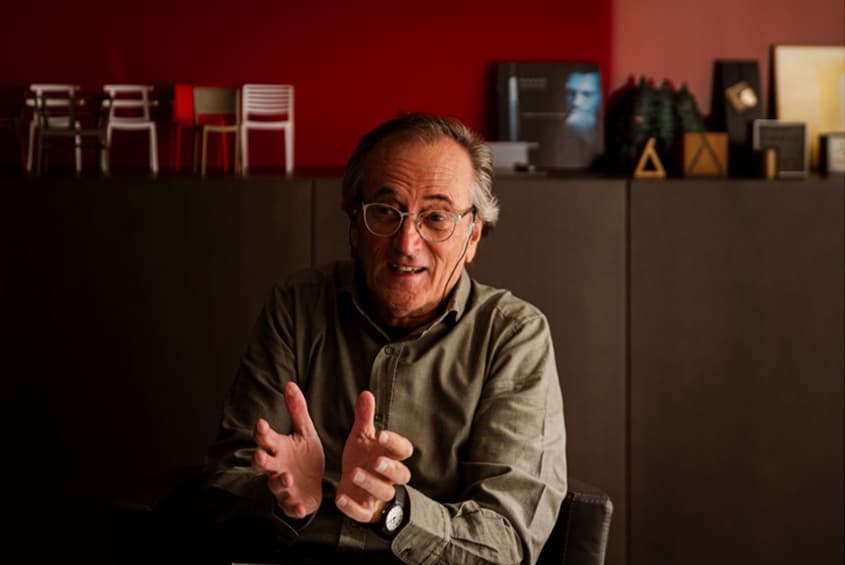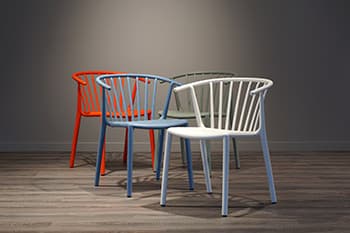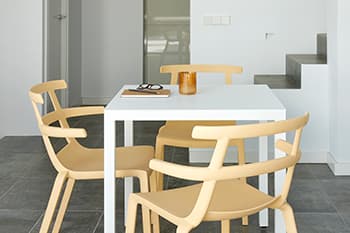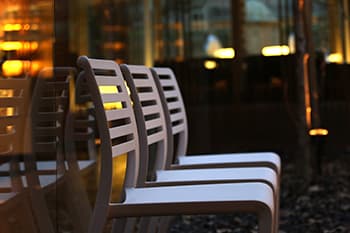Blog
“REST is an elegant, warm, welcoming armchair that exudes a real feeling of comfort”

Josep Lluscà (Barcelona, 1948) welcomes us at his studio located opposite the Turó del Putxet Gardens. The designer exudes peace from his calm gaze. He invites us to take a seat in the bright meeting room, which the first beams of morning light are shining into. Chair miniatures, books on design and catalogues are propped on top of a piece of furniture behind him, all neat and tidy. And so, we begin an enjoyable conversation about his relationship with Resol and his latest design for the firm, the REST collection, which will be presented at the Milan Furniture Fair, in mid-April.
RESOL is about to present a new collection of chairs, called REST, created by your studio. How would you define the essence of this collection in a single sentence?
Elegant armchairs, with a natural, timeless and updated image of a revisited classic. An aesthetic that is minimalist yet formally expressive, warm, welcoming and that exudes a real feeling of comfort.
What unique features will make REST a collection that stands out from its competitors?
The idea of designing a unique four-leg structure in injected polypropylene that could accommodate a range of backrests, seats and arms with soft upholstery and with different aesthetics and functionalities.
What was RESOL’s role and how was the initial idea developed?
Resol commissioned me to design a chair upholstered with polyurethane foam and injected polypropylene legs, that would be comfortable. In other words, a chair functioning as an armchair that favours comfort. We came up with the name based on this initial idea given how REST was designed to make time stop and take a moment to take a break.
The collection initially consisted of two models, REST and REST LOW. What are the main differences and what are the intended use of these models?
This collection can be expanded over time and is intended for both home and contract use in general, such as hospitality, catering, waiting rooms, reception, libraries etc.
You are a great connoisseur of the RESOL brand, you have been working with this company for many years. Of all the projects you have worked on, which do you remember most fondly?
The Tokyo chair, due to its bold image, without sacrificing simplicity, economy of materials and comfort. I think that when it comes to the design of a product, it is not only about making it different but also about making it better. I’m turned off by luxury and ostentation, while comfort and utility give me a sense of wellbeing.
Explain a little more about Tokyo’s creative process
There are two ways of designing: one that is riskier where the results are not immediately apparent, and another, where they are seen straight away. Designers have to move out of their comfort zone and access their wildest side of design, I’m talking about that stage that is bordering on extravagance, originality… and when it came to Tokyo, we really went for it. We knew it had to be different, but even better than different… So, I thought of a human skeleton, as a complete form, as Chillida used to say. We began to empty this volume, cutting out any parts that were not necessary, achieving maximum lightness. We kept only the very essential. Then we started to see something reminiscent of typical Japanese doors, in the style of a torii, and we really threw ourselves in headfirst. This is how Tokyo was created.
Some time later some of the parts that had to be cut out of the initial complete form were filled in again to expand the Tokyo range. Everything fits into place...
Yes, that's right. And this allowed us to expand the range with an option including an upholstered backrest.
Many of his designs for RESOL have become iconic pieces, due to their recognition, such as the Woody chair and stool, the Tokyo chair and the Lama chair. How do you receive this recognition?
There are two moments that particularly spark my attention when creating a product: firstly, the emotion leading to the challenge of facing a new and unknown project, and secondly the satisfaction of the subsequent recognition when the design has been realised. Adrenaline and serotonin.
RESOL has a long history as a manufacturer of polypropylene furniture basically for outdoor use, while recently having expanded its catalogue with a range for indoor use, in which it has contributed its two cents’ worth with collections designed by your studio such as Skin or Shape. How do you view this extended range?
As a natural evolution: on the one hand we have plastic material injection technology that offers major benefits such as durability, ease of cleaning etc., and on the other hand the option of improving comfort through the upholstery.
As a product designer you are and have always been in contact with many companies. Which of RESOL’s values stand out most for you?
Apart from the superb human team working for the company, the ability to produce objects from a single material that can be recycled with amazing ease. A single piece chair does not need to be disassembled or separate different parts to do so. Its great value for money also allows a large majority of people to be able to afford it.
Let’s talk about Josep Lluscà. You have designed different product sets. In the specific case of chairs, we have heard you say on more than one occasion that the chair, apart from being aesthetically attractive, has to be comfortable. Can you expand on this idea a little more?
A chair that simply looks beautiful does not make sense. The act of creating an object consists of an intellectual process where all the factors involved in it are equally important. In other words, it is impossible to place more importance on form, function, utility, aesthetics, materials, technology or ergonomics compared to other factors, given how all of them as a whole is precisely what must guide us to the optimal solution.
Your study has been around for 50 years. How would you sum up your activity over all of these years?
I have learned something new from each of the projects I have created with my team, although I always think I could have done better. That is why I am constantly looking for a new challenge, a new opportunity. And that is what we are going to dedicate the next 50 years to.
What is one thing that you would love to design that you still haven’t done?
I wish I could design a city. And why not!
Wow! A whole city. What an amazing project, tell us more…
It is a utopia but let me explain it better. Before you can design anything, you need to get to know people. A city is where people live. I am not a cartoonist. For me to design is to think, to observe… and drawing is a tool to express what I see and how I can transform it. A good design is something that can be explained. Something that starts off from an idea and that can have millions of forms. As well as the shape of a city.
A chair is also very much related to people and their well-being, right?
Yes, absolutely. Mies van der Rohe said that it is more difficult to think of a chair than a building. I love designing chairs because of their direct relationship with the human body. A chair is still the mould of a person's body.
How do you view product design in Catalonia and Spain?
Bright, young, mature and consolidated.
Is the big challenge today the search for new materials rather than making innovative designs or do the two things go together?
Innovation needs to involve both new and traditional materials.
From your experience, what message would you give to young designers?
Designing is anticipating, forecasting, thinking about things that do not yet exist. A designer sees things before anyone else does. They must observe the world, see what people are doing, what their needs are. Desire and curiosity are what drive creation.
The conversation ends with some more remarks on the urban changes taking place in Barcelona, the internationality of Spanish design and other ideas on the limits of industrial design and art. We could talk forever with Josep Lluscà and try to absorb his great knowledge about design and people, which he transmits without being boisterous, projecting wisdom in the most discreet fashion.


